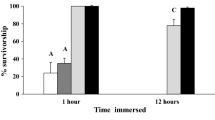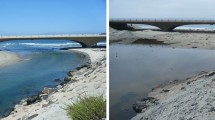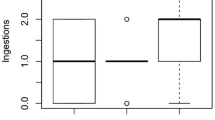Abstract
Interactive effects of three alternating normoxia-hypoxia cycles on benthic prey exploitation by mobile fish (spot, Leiostomus xanthurus; and hogchoker, Trinectes maculatus) and a burrowing crustacean (Squilla empusa) were investigated in the York River, Chesapeake Bay, Virginia, USA, in 1989. Predators collected in four depth strata (A: 5 to 10 m; B: 10 to 14 m; C: 14 to 20 m; D:>20 m) variously affected by hypoxia were separated into size classes (three for spot and two each for hogchoker and mantis shrimp) to examine potential ontogenetic influences in prey selection. The most severe effects of hypoxia on the benthos occurred in the two deepest strata (C and D) and decreased in shallower strata (B>A), with Stratum A never affected by low oxygen. Predators investigated exhibited dietary evidence of optimal prey exploitation during or immediately after hypoxic events. In most instances gut contents contained significantly larger, deeper-burrowing prey during periods of low oxygen than during alternating peroids of normal oxygen levels. Spot consumed a greater biomass (45 to 73%) of polychaetes than other prey, with crustaceans initially also constituting a main dietary component but decreasing in importance later in the study period. The deep-burrowing anemone, Edwardsia elegans, was an important prey species for spot, particularly in the lower depth strata affected by hypoxia. Prey consumed by 10-to 15-cm-long spot increased significantly in size during some hypoxic events, suggesting a sublethal effect of hypoxia on large benthic species. Polychaetes (primarily Glycera americana, Notomastis latericeus and Loimia medusa) were dominant dietary components in hogchoker, making up between 85 and 98% of the diet. Bivalve siphons became important prey for hogchoker in the three deepest strata and were only consumed after the August hypoxia. Stomach contents of mantis shrimp were difficult to identify in most instances due to the near complete mastication of consumed prey. Crustaceans were important prey initially but became less conspicuous in the diet subsequent to the July hypoxia event, when hydroids became more dominant. Overall, predator species exhibited optimal exploitation of moribund or slowly recovering benthos affected by hypoxia. The sublethal effects of hypoxia through increased availability of benthos to resident predators can have important consequences for energy flow in areas such as the York River which experience periodic low-oxygen cycles.
Similar content being viewed by others
Literature cited
Agresti, A. (1990). Categorical data analysis John Wiley & Sons, New York
Baden, S. P., Loo, L.-O., Pihl, L., Rosenberg, R. (1990). Effects of eutrophication on benthic communities including fish: Swedish west coast. Ambio 19(3): 113–122
Beckman, D. W., Dean, J. M. (1984). The age and growth of young-of-the-year spot, Leiostomus xanthurus Lacépéde, in South Carolina. Estuaries 7: 487–496
Blundon, J. A., Kennedy, V. S. (1982). Refuges for infaunal bivalves from blue crab, Callinectes sapidus (Rathbun), predation in Chesapeake Bay. J. exp. mar. Biol. Ecol. 65: 67–81
Boesch, D. F., Schaffner, L. C., Bowen, M. A., van Montfrans, J., Swarts, R. C. (1991). Benthic community dynamics following a plankton bloom and hypoxia in the New York Bight. Estuar. cstl Shelf Sci. (in press)
Burd, B. J., Brinkhurst, R. O. (1984). The distribution of the galatheid crab Munida quadrispinosa (Benedict 1902) in relation to oxygen concentrations in British Columbia fiords. J. exp. mar. Biol. Ecol. 81: 1–20
Calder, D. R. (1971). Hydroids and hydromedusae of southern Chesapeake Bay. Va Inst. mar. Sci. spec. scient. Rep 1: 1–125
Calder, D. R. (1990). Seasonal cycles of activity and inactivity in some hydroids from Virginia and South Carolina, U.S.A. Can. J. Zool. 68: 442–450
Caldwall, R. L., Dingle, H. (1976). Stomatopods. Scient. Am. 234: 81–89
Chao, L. N., Musick, J. A. (1977) Life history, feeding habits and functional morphology of juvenile sciaenid fishes in the York River estuary, Virginia. Fish. Bull. U. S. 75: 657–702
Cohen, R. R. H., Dresler, P. V., Phillips, E. J. P., Cory, R. L. (1984). The effect of the Asiatic clam, Corbicula fluminea, on phytoplankton of the Potomac River, Maryland. Limnol. Oceanogr. 29: 170–180
de Groot, S. J. (1971). On the interrelationships between morphology of the alimentary tract, food and feeding behaviour in flatflishes (Pisces: Pleuronectiformes). Neth. J. Sea Res. 5(2): 121–196
Diaz, R. J., Neubauer, R. J., Schaffner, L. C., Pihl, L. Baden, S. P. (in press). Continuous monitoring of dissolved oxygen in an estuary experiencing periodic hypoxia and the effect of hypoxia on macrobenthos and fish. In: Proceedings of the Marine Coastal Eutrophication International Conference, Bologna 1990. Elsevier, Amsterdam
Dovel, W. L., Mihursky, J. A., McErlean, A. J. (1969). Life history aspects of the hogchoker Trinectes maculatus in the Patuxent River estuary, Maryland. Chesapeake Sci. 10(2): 104–119
Elmgren, R. (1989). Mans' impact on the ecosystem of the Baltic Sea: energy flows today and at the turn of the century. Ambio 18: 326–332
Fleiss, J. L. (1981). Statistical methods for rates and proportions. John Wiley & Sons, New York
Haas, L. W. (1977). The effect of spring-neap tidal cycle on the vertical salinity structure of the James, York and Rappahannock Rivers, Virginia, USA. Estuar. cstl mar. Sci. 5: 485–496
Hamano, T., Matsuura, S. (1986). Food habits of the Japanese mantis shrimp in the benthic community of Hakata Bay. Bull. Jap. Soc. scient. Fish. 52(5): 787–794
Hayward, D., Haas, L. W., Boon, J. D., Webb, K. L., Friedland, K. D. (1986). Empirical models of stratification variation in the York River estuary. Virginia USA. In: Bowman, H. J., Yentsch, C. M., Peterson, W. T. (eds.) Tidal mixing and plankton dynamics. Lecture notes on coastal and estuarine studies, Vol. 17. Springer-Verlag, Berlin, p. 346–367
Hines, A. H., Contois, K. L. (1984). Vertical distribution of infauna in sediments of a subestuary of central Chesapeake Bay. Estuaries 8: 296–304
Holland, A. F., Shaughnessey, A. T., Hiegel, M. H. (1987). Longterm variation in mesohaline Chesapeake Bay macrobenthos: spatial and temporal patterns. Estuaries 10: 227–245
Jørgensen, B. B. (1980). Seasonal oxygen depletion in the bottom waters of a Danish fjord and its effect on the benthic community. Oikos 34: 68–76
Kobylinski, G. J., Sheridan, P. F. (1979). Distribution, abundance, feeding and long-term fluctuations of spot Leiostomus xanthurus, and croaker Micropogonias undulatus, in Apalachicola Bay, Florida, 1972–1977. Contr. mar. Sci. Univ. Tex. 22: 149–161
Koski, R. T. (1978). Age, growth and maturity of the hogchoker, Trinectes maculatus in the Hudson River, New York. Trans. Am. Fish. Soc. 107(3): 449–453
Kuo, A. Y., Neilson, B. J. (1987). Hypoxia and salinity in Virginia estuaries. Estuaries 10: 277–283
Llanso, R. J. (1990). Effects of low dissolved oxygen on the macrobenthos of the Rappahannock River, Chesapeake Bay. Ph.D. thesis, College of William and Mary, Williamsburg, Virginia
Malone T. C., Croker, L. H., Pike, S. E., Wendler, B. W. (1988). Influences of river flow on the dynamics of phytoplankton production in a partically stratified estuary. Mar. Ecol. Prog. Ser. 48: 235–249
Malone, T. C., Kemp, W. M., Ducklow, H. W., Boynton, W. R., Tuttle, J. H., Jonas, R. B. (1986). Lateral variation in the production and fate of phytoplankton in a partically stratified estuary. Mar. Ecol. Prog. Ser. 32: 149–160
Manning, R. B. (1969). Stomatopod Crustacea of the western Atlantic. Stud. trop. Oceanogr., Miami 8: p. 380
Markle, D. F. (1976). The seasonality of availability of movements of fishes in the channel of York River, Virginia. Chesapeake Sci. 17(1): 50–55
May, E. B. (1973). Extensive oxygen depletion in Mobile Bay, Alabama. Limnol. Oceanogr. 18: 353–366
McCain, J. C. (1965). The Caprellidae (Crustacea: Amphipoda) of Virginia. Chesapeake Sci. 6: 190–196
Mountford, K., Reynolds, R., Fisher, N. (1989). A telemetric environmental data buoy in Chesapeake Bay. In: Marine Technology Society Proceeding of Marine Data Systems '89, April 1989, New Orleans, p. 17–22
O'Connor, J. M. (1972). Tidal activity rhythm in the hogchoker, Trinectes maculatus (Bloch & Schneider). J. exp. mar. Biol. Ecol. 9: 173–177
Officer, C. B., Briggs, R. B., Taft, J. L., Cronin, L. E., Tyler, M. A., Boynton, W. R. (1984). Chesapeake Bay anoxia. Origin, development and significance. Science, N.Y. 223: 22–27
O'Niel, S. P., Weinstein, M. P. (1987). Feeding habitats of spot, Leiostomus xanthurus, in polyhaline versus meso-oligohaline tidal creeks and shoals. Fish. Bull. U.S. 85(4): 785–796
Palmer, M. A., Molloy, R. M. (1986). Water flow and vertical distribution of meiofauna: a flume experiment. Estuaries 9: 225–228
Peters, D. S., Boyd, M. T. (1972). The effect of temperature, salinity, and availability of food on the feeding and growth of the hogchoker, Trinectes maculatus (Bloch & Schneider). J. exp. mar. Biol. Ecol. 9: 201–207
Pianka, E. R. (1978). Evolutionary ecology. Harper & Row, New York
Pihl, L. (1989). Effects of oxygen depletion on demersal fish in coastal areas of the south east Kattegat. Proc. 23rd Eur. mar. Biol. Symp., p. 431–439, [Ryland, J. S., Tyler, P. A. (eds.) Olsen & Olsen, Fredensborg, Denmark]
Pihl, L., Baden, S. P., Diaz, R. J. (1991). Effects of periodic hypoxia on distribution of demersal fish and crustaceans. Mar. Biol. 108: 349–360
Reading, C. J., McGrorty, S. (1978). Seasonal variation in the burying depth of Macoma baltica (L.) and its accessibility to wading birds. Estuar. cstl mar. Sci. 6: 135–144
Roberts, D., Rittschof, D., Merhart, D. J., Schmidt, A. R., Hill, L. G. (1989). Vertical migration of the clam Mercenaria mercenaria (L.) (Mollusca: Bivalvia): environmental correlates and ecological significance. J. exp. mar. Biol. Ecol. 126: 271–280
Rosenberg, R. (1977). Benthic macrofaunal dynamics, production and dispersion in an oxygen-deficient estuary of West Sweden. J. exp. mar. Biol. Ecol. 26: 107–113
Rosenberg, R., Elmgren, R., Fleischer, S., Jonsson, P., Persson, G., Dahlin, H. (1990). Marine outrophication case studies in Sweden: a synopsis. Ambio 19(3): 102–108
Rosenberg, R., Loo, L.-O. (1988). Marine eutrophication induced oxygen deficiency: effects on soft bottom fauna, western Sweden. Ophelia 29: 213–225
Rossignol-Strick, M. (1985) A marine anoxic event on the Brittany coast, July 1982. J. cstl Res. 1: 11–20
Ruppert, E., Fox, R. (1988) Seashore animals of the southeast. Univ. South Carolina Press, Columbia
Schaffner, L. C. (1990). Small-scale organism distribution and patterns of species diversity: evidence for positive interactions in an estuarine benthic community. Mar. Ecol. Prog. Ser. 61: 107–117
Stachowitsch, M. (1984). Mass mortality in the Gulf of Trieste: the course of community destruction. Pubbl. Staz. zool. Napoli (I. Mar. Ecol.) 5: 243–264
Steimle, F. W., Radosh, D. J. (1979). Effects on benthic communities. In: Swanson, R. L., Sinderman, C. J. (eds.) Oxygen depletion and associated benthic mortalities in New York Bight, 1976. NOAA Professional Paper 11. NOAA, Washington, DC, p. 281–293
Stickney, R. R., Taylor, G. L., White, D. B. (1975). Food habits of five species of southeastern United States estuarine Sciaenidae. Chesapeake Sci. 16: 104–114
Wass, M.L. (1972). A check list of the biota of lower Chesapeake Bay. Va Inst. mar. Sci. spec. scient. Rep. 65: p. 290
Zwarts, L., Esselink, P. (1989). Versatility of male eurlews (Numenius arquata) preying upon Nereis diversicolor: deploying contrasting capture modes dependent on prey availability. Mar. Ecol. Prog. Ser. 56: 255–269
Author information
Authors and Affiliations
Additional information
Communicated by T. Fenchel, Helsingør
Rights and permissions
About this article
Cite this article
Pihl, L., Baden, S.P., Diaz, R.J. et al. Hypoxia-induced structural changes in the diet of bottom-feeding fish and Crustacea. Marine Biology 112, 349–361 (1992). https://doi.org/10.1007/BF00356279
Accepted:
Published:
Issue Date:
DOI: https://doi.org/10.1007/BF00356279




